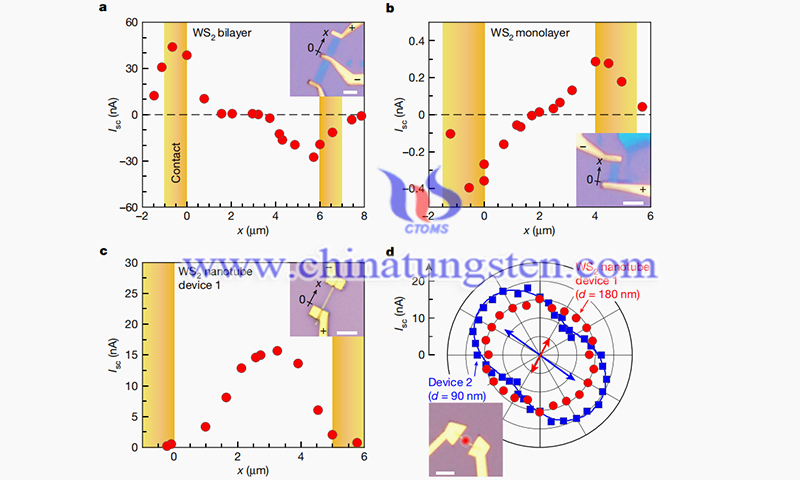Enhanced Intrinsic Photovoltaic Effect in Tungsten Disulfide Devices
- Details
- Category: Tungsten Information
- Published on Monday, 31 October 2022 21:20
The bulk photovoltaic effect (BPVE) found in tungsten disulfide devices could further enhance energy conversion rates. The BPVE in conventional p-n junctions - where p-type materials (with excess holes) are adjacent to n-type materials (with excess electrons) - generates current through the light-induced generation and separation of electron-hole pairs. This BPVE is particularly important in energy applications, and its efficiency is now approaching its theoretical limit.

Further efficiency gains are expected to be achieved by exploiting the BPVE, which does not require junctions and occurs only in crystals with broken inversion symmetry. However, the practical application of BPVE is hampered by its low efficiency in existing materials. It has been proposed that semiconductors with small sizes or smaller band gaps are more efficient. Transition-metal dichalcogenides (TMDs) are typical small bandgap 2D semiconductors, and various effects have been obtained by breaking the inherent inversion symmetry of their bulk crystals.
Recent studies report on the BPVE found in tungsten disulfide devices based on tungsten disulfide, a member of the TMD family, systematically reducing crystal symmetry beyond inversion symmetry - from two-dimensional monolayers to nanotubes with polarities that greatly enhance BPVE. this produces photocurrent densities several orders of magnitude greater than other BPVE materials. Our results highlight not only the potential of TMD-based nanomaterials, but more generally the importance of crystal symmetry reduction for improving the efficiency of converting solar energy into electrical energy.
Tungsten disulfide (WS2) and other groups VI-B TMDs are two-dimensional semiconductors with a relatively small band gap of 1.2-2.1 eV. In their most stable 2H phase, the unit cell of the bulk TMD is centrosymmetric and the material belongs to the D6h point group. However, since the unit cell is composed of a bilayer, it is possible to break the inversion symmetry by isolating just one individual layer. The monolayer belongs to the non-centrosymmetric and non-polar D3h point group.

In such a monolayer, BPVE can occur as long as the incident light is linearly polarized along a specific direction - it converts solar energy into electricity without the need for a p-n junction, which circularly polarized light does not allow. When the triple rotation and mirror symmetry of a two-dimensional sheet are removed by curvature or strain, light can induce BPVE regardless of its polarization properties.
The researchers studied BPVE in WS2 devices with successively lower crystal symmetry, i.e., centrosymmetric bilayers, non-centrosymmetric nonpolar monolayers, and finally non-centrosymmetric polar nanotubes. The latter are multi-walled nanotubes with hollow cores, as shown in representative transmission electron microscopy (TEM) images. These devices have chromium and gold electrodes.
Cited paper: Zhang Y J, Ideue T, Onga M, et al. Enhanced intrinsic photovoltaic effect in tungsten disulfide nanotubes[J]. Nature, 2019, 570(7761): 349-353.
- Tungsten Manufacturer & Supplier, Chinatungsten Online: www.chinatungsten.com
- Tungsten News & Prices of China Tungsten Industry Association: www.ctia.com.cn
- Molybdenum News & Price: news.molybdenum.com.cn
- Tel.: 86 592 5129696; Fax: 86 592 5129797; Email: sales@chinatungsten.com



 sales@chinatungsten.com
sales@chinatungsten.com